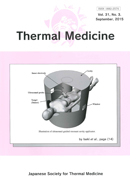All issues

Volume 31 (2015)
- Issue 4 Pages 27-
- Issue 3 Pages 13-
- Issue 2 Pages 5-
- Issue 1 Pages 1-
Volume 31, Issue 3
Displaying 1-1 of 1 articles from this issue
- |<
- <
- 1
- >
- >|
Original Paper
-
- Non-invasive Measurement of Temperature Distributions -YUYA ISEKI, KEITO NAKAMURA, DAISUKE ANAN, KAZUO KATO2015 Volume 31 Issue 3 Pages 13-26
Published: September 30, 2015
Released on J-STAGE: December 04, 2015
JOURNAL FREE ACCESSThis paper describes the ultrasound-guided resonant cavity applicator system which has a function for measuring temperature distributions non-invasively. We had already proposed the resonant cavity applicator for non-invasive hyperthermia treatments. In this heating system, it was shown that the applicator could heat deep seated tumor without undesirable hotspots. In addition, the resonant cavity applicator could control the heated area inside tumors corresponding to the symptom of the patients. In the clinic, a real time monitoring system to acquire the targeted area and temperature distributions inside human body is necessary for effective hyperthermia treatments. In this paper, we proposed the ultrasound-guided resonant cavity applicator system which has a possibility of measuring temperature distributions inside human body. The method of measuring temperature distributions was based on the thermal dependence of local change in speed of sound and thermal expansion. Here, we described the method to estimate temperature distributions inside the agar phantom heated by the developed ultrasound-guided resonant cavity applicator. First, we tried to heat the agar phantom inside a hot water bath to discuss the relationship between temperature rises and changes of the ultrasound images. Next, we measured temperature distributions inside the agar phantom heated by the resonant cavity applicator using a diagnostic ultrasound imaging system. Also, we discussed the results of the measured temperature distributions inside the agar phantom for controlling the heated area. From our heating experiments, it was confirmed that the proposed method was useful to measure temperature distributions and hotspot locations inside the heated object non-invasively.View full abstractDownload PDF (964K)
- |<
- <
- 1
- >
- >|